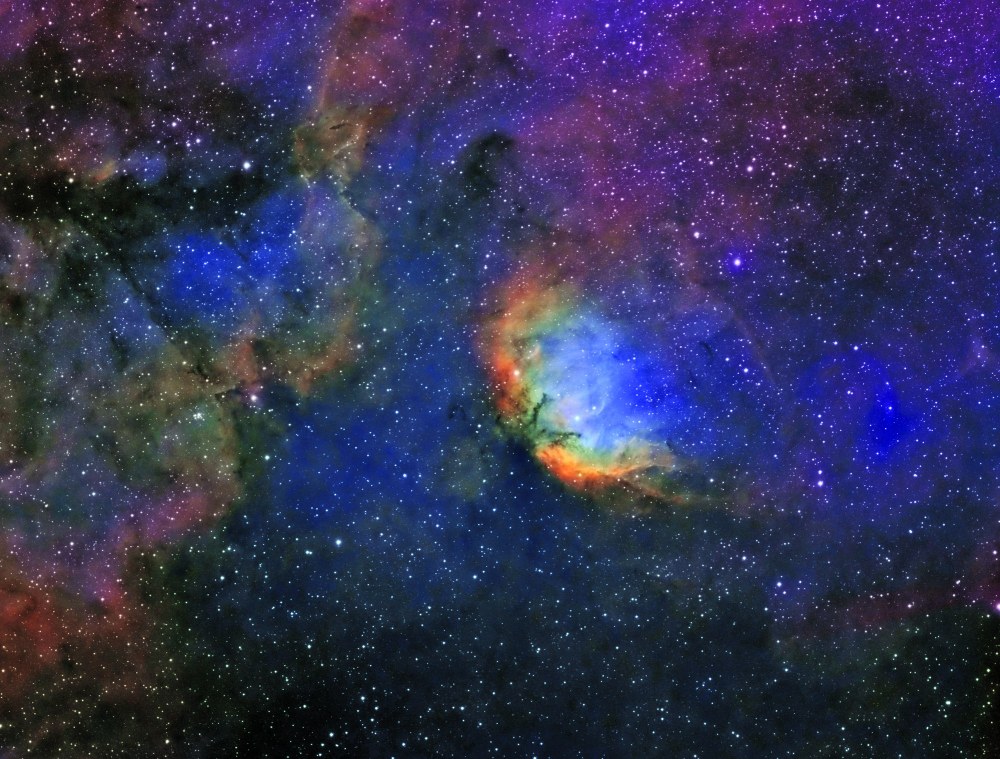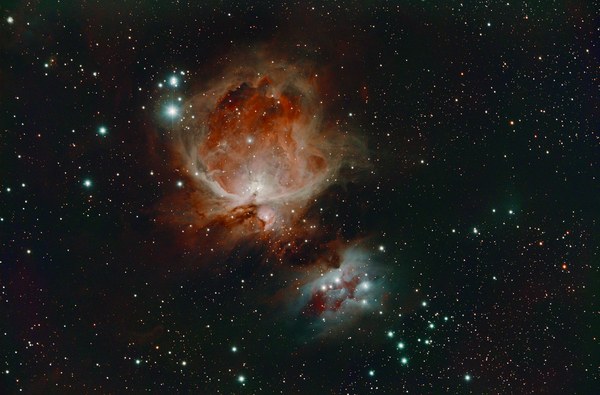
Mountaineers spend their days looking down the trail, across the horizon, and toward the peaks. We plan our logistics around daylight, often aiming to avoid pitch darkness. If we find ourselves in nightfall, we may briefly praise the luminous celestial bodies that dot the sky, but typically, our time in the night is temporary. Yet, extending time under the night sky is exactly what Alan Vogt and Keith Krumm encourage. Alan, the Seattle Night Sky Committee Chair, and Keith, a Seattle Night Sky Course instructor, are eager to pique curiosity about the astronomical entities that occupy our night sky.
After years of membership with the Seattle Astronomical Society and the Goldendale Sky Village, Alan and Keith recognized the need for more beginner-friendly, educational platforms to support beginner stargazers. In 2021, with the help of Sabrina Minnick, they created the Seattle Night Sky Committee. Their goal was simple: to teach Mountaineers how to sit back, look up, and admire all that the cosmos has to offer. As Keith shares, they wanted to “provide an opportunity for people to learn more about the night sky, and then go out and experience it,” through telescopes, binoculars, or even eyes alone.
Their enthusiasm for teaching new students stems from spontaneous interactions with strangers and neighbors. Individuals often ask Alan or Keith about what they see while stationed at a public area, like a park, with their equipment. “My favorite part of astronomy is bringing new people into it,” says Alan. At these unexpected encounters, Alan and Keith may point out the Moon, Mars, or Jupiter. Keith shares that when showing individuals celestial objects for the first time, “it’s like a light bulb goes off.” The delight and amazement of these beginners is what motivates these two astronomers to continue teaching others to enjoy the night sky.
The Night Sky and Astronomy Course
While most activities at The Mountaineers strive to end their trips and field trips before dark, for the Night Sky Committee, everything is done at night. The reason is obvious: after the sun sets you are primed to “see some cool stuff.”
When participating in a night sky activity, your main objective doesn’t have to be stargazing. The joys of the night sky can be integrated into other daytime activities where you can safely remain in your trip location until it becomes dark, like enjoying the evening sky during a backpacking trip. You don’t even need a telescope to enjoy a dark sky. “A good pair of binoculars will open up the skies unbelievably,” explains Alan. In addition to binocular use, students in the Night Sky and Astronomy Course will learn how to operate telescopes, navigate the night sky, and identify nighttime objects, as well as dark sky etiquette and safety. The course field trip occurs at Goldendale Sky Village, the premier dark sky area in the Pacific Northwest, and combines single or multi-night camping with ample observation time and shared astronomy equipment so that students can experience the wonders of an extraordinary night sky.
Even though the committee and course are just getting started, Mountaineers are singing their praises. One student highlighted the generosity experienced on a field trip last year, saying “many other volunteers showed up with telescopes and shared their scopes and knowledge. It was very clearly a large community of generous, enthusiastic folks that created an excited, infectious vibe during the entire course.”
Fostering future night sky enthusiasts
With five years of stargazing experience, Alan admits he still considers himself a “newbie,” but he draws on decades' worth of experience from Keith, Sabrina, and the rest of the committee to elevate course instruction. Keith is happy to oblige. "I love the teaching part," he says. Under their instruction, even common sky sights become unforgettable highlights. Both recall moments of excitement after showing a beginner the Moon or a planet through their telescopes, even from a light-polluted area like Seattle. The chance to exhibit the many facets of the night sky, from the remarkable to the familiar, fuels their mission to educate.
After two years of successful courses, they are excited to reach even more curious Mountaineers as they embark on year three of the Night Sky and Astronomy Course. Their course is especially important since public astronomy classes are scarce in Washington. Most local astronomy classes are offered through college courses, and while Alan and Keith may not be teaching a full-fledged college course, they are keen on expanding their course offerings. “Right now, we're just covering the basics [of astronomy]” Alan shares, “but who knows what we'll do in the future.” Their top goal for this year is to engage even more aspiring night sky enthusiasts to explore, conserve, learn about, and enjoy the lands, waters, and skies of the Pacific Northwest and beyond.
The Seattle Night Sky Committee offers courses in late spring to early summer, with the possibility of fall courses in 2023. If you are interested in a course or joining as a volunteer, visit the Seattle Night Sky at mountaineers.org/seattle-night-sky-committee.
NIGHT SKY LIGHTNING ROUND
Favorite dark sky sites
Alan: Kerry Park - You can’t see the constellations but you can see the planets and the moon really well.
Keith: Bryce Canyon - They have an astronomy festival every June.
Favorite constellations
Alan: The Orion constellation in winter, and Albiero in the summer, a double star system in the constellation Cygnus.
Keith: Mizar and Alcor, a double star system in the Big Dipper constellation.
Favorite stargazing tips for beginners
Alan: Take a trip away from the city’s light pollution. The farther you get from Seattle, the darker the sky is going to be, and the better you're gonna be able to see the stars.
Keith: Download an app called SkySafari.
Bucket list items
Alan: Sunrise at Paradise on Mt. Rainier, as well as Hurricane Ridge.
Keith: The northern lights.
 The Orion Nebula also known as M42.
The Orion Nebula also known as M42.
LEADER PRO TIP: YOUR RISK MANAGEMENT TEAM
When it comes to managing risk, being intentional with your team about decision-making processes can make all the difference. It is easy for individuals to take a step back and defer to the official leader, or to the person with the most experience or loudest voice. But as a leader, your team is often your best resource for managing risk, regardless of their experience. Your job is to empower them to participate in risk management. Our least experienced participants are often the ones who will notice something out of the ordinary, so we must empower every individual to speak up if something feels wrong. An environment of psychological safety will allow all team members to speak up if they notice a personal or group risk that must be addressed.
Psychological safety is an environment in which all participants feel comfortable fully engaging. It empowers participants to speak up with questions or ideas without fear of negative consequences. This is critical to team risk management and has a direct impact on physical safety.
Want to continue expanding your leadership and instruction skills? Check out the Foundations of Leadership, Foundations of Instruction, and Emotional Safety in the Outdoors eLearning Courses.
This article originally appeared in our summer 2023 issue of Mountaineer magazine. To view the original article in magazine form and read more stories from our publication, visit our magazine archive.
 Michelle Song
Michelle Song